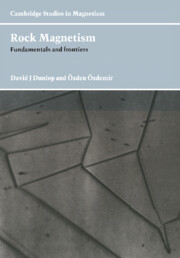Book contents
- Frontmatter
- Contents
- Preface
- Chapter 1 Magnetism in nature
- Chapter 2 Fundamentals of magnetism
- Chapter 3 Terrestrial magnetic minerals
- Chapter 4 Magnetostatic fields and energies
- Chapter 5 Elementary domain structures and hysteresis
- Chapter 6 Domain observations
- Chapter 7 Micromagnetic calculations
- Chapter 8 Single-domain thermoremanent magnetization
- Chapter 9 Multidomain thermoremanent magnetization
- Chapter 10 Viscous and thermoviscous magnetization
- Chapter 11 Isothermal magnetization and demagnetization
- Chapter 12 Pseudo-single-domain remanence
- Chapter 13 Crystallization remanent magnetization
- Chapter 14 Magnetism of igneous rocks and baked materials
- Chapter 15 Magnetism of sediments and sedimentary rocks
- Chapter 16 Magnetism of metamorphic rocks
- Chapter 17 Magnetism of extraterrestrial rocks
- References
- Index
Chapter 1 - Magnetism in nature
Published online by Cambridge University Press: 06 July 2010
- Frontmatter
- Contents
- Preface
- Chapter 1 Magnetism in nature
- Chapter 2 Fundamentals of magnetism
- Chapter 3 Terrestrial magnetic minerals
- Chapter 4 Magnetostatic fields and energies
- Chapter 5 Elementary domain structures and hysteresis
- Chapter 6 Domain observations
- Chapter 7 Micromagnetic calculations
- Chapter 8 Single-domain thermoremanent magnetization
- Chapter 9 Multidomain thermoremanent magnetization
- Chapter 10 Viscous and thermoviscous magnetization
- Chapter 11 Isothermal magnetization and demagnetization
- Chapter 12 Pseudo-single-domain remanence
- Chapter 13 Crystallization remanent magnetization
- Chapter 14 Magnetism of igneous rocks and baked materials
- Chapter 15 Magnetism of sediments and sedimentary rocks
- Chapter 16 Magnetism of metamorphic rocks
- Chapter 17 Magnetism of extraterrestrial rocks
- References
- Index
Summary
Magnetism has fascinated mankind since the invention of compasses that could track invisible magnetic field lines over the earth's surface. Much later came the discovery that rocks can fossilize a record of ancient magnetic fields. Unravelling this record – the ‘archeology’ of magnetism – is the science of paleomagnetism, and understanding how the microscopic fossil ‘compasses’ in rocks behave has come to be known as rock magnetism.
Rock magnetism is both a basic and an applied science. Its fundamentals concern ferromagnetism and magnetic domains and were developed most authoritatively by Néel. Its applications continue to expand, giving impetus to new research into the mechanisms and fidelity of rock magnetic recording. Some of the history and applications are described in this chapter.
A brief history
Earth magnetism
Compasses were used in China and the Arab world for centuries before Petrus Peregrinus in 1269 gave the first European description of a working compass. The earliest compasses were lodestones, naturally occurring ores of magnetite (Fe3O4). Particular areas, or poles, of one lodestone would attract or repel the poles of another lodestone. This magnetic polarization is the key to their use as compasses in navigation. A suspended lodestone will rotate until its axis of magnetization or polarization, joining north and south poles of the lodestone, lines up with imaginary field lines joining the north and south geomagnetic poles. In modern terminology, the magnetization M aligns with the field H.
- Type
- Chapter
- Information
- Rock MagnetismFundamentals and Frontiers, pp. 1 - 15Publisher: Cambridge University PressPrint publication year: 1997
- 32
- Cited by



